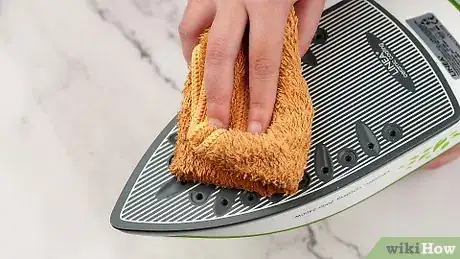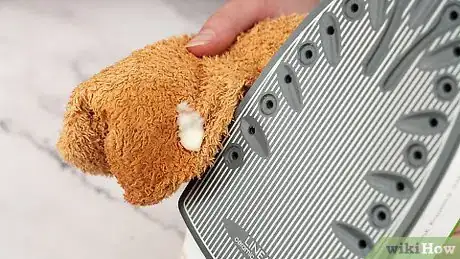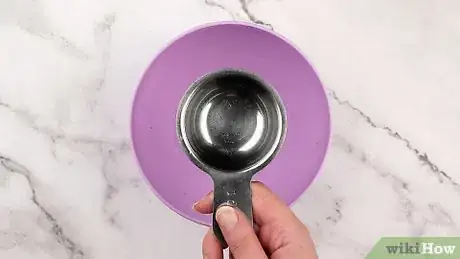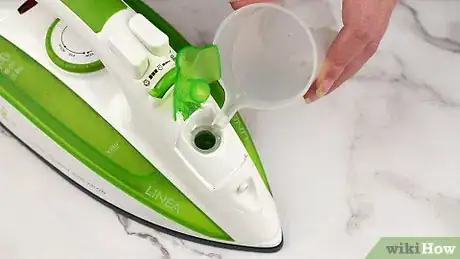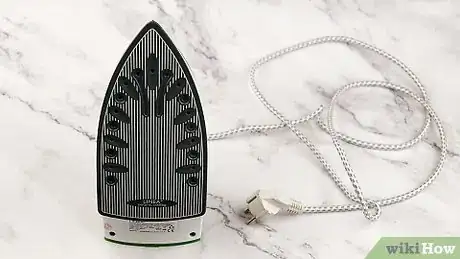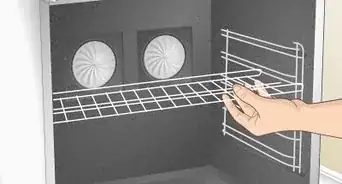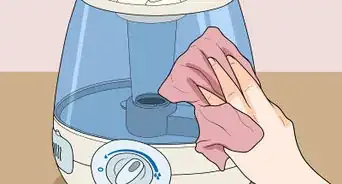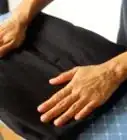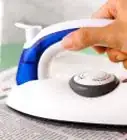This article was co-authored by Bridgett Price. Bridgett Price is a Cleaning Guru and Co-Owner of Maideasy, a maid service company that services the Phoenix, Arizona metropolitan area. She holds a Master of Management from the University of Phoenix, specializing in digital and traditional marketing.
wikiHow marks an article as reader-approved once it receives enough positive feedback. This article received 12 testimonials and 80% of readers who voted found it helpful, earning it our reader-approved status.
This article has been viewed 355,126 times.
Although a steam iron is not used as frequently today as it has been in the past, it's still very helpful for starching a dress shirt, freshening table linens and cloth napkins, removing wrinkles from curtains and furniture slips, or even adhering a favorite decal to an ordinary T-shirt. Cleaning your iron and keeping it in great condition are key to its longevity—and we're here to show you how you can keep your appliance in tip-top shape. With a little care and an occasional cleaning, you can help your iron last for years.
Things You Should Know
- Wipe down the base plate with a 1:1 ratio of distilled white vinegar and table salt. If your iron isn't non-stick, clean the plate with a store-bought cleaner instead.
- Pour 1⁄2 c (120 mL) of both water and distilled white vinegar into the iron and run it. Then, empty the iron and run it with just fresh water.
- Keep your steam iron in great condition by regularly scraping off melted plastic, using the right type of water, inspecting the power cord, and storing the iron carefully.
Steps
Cleaning the Base Plate
-
1Mix equal parts table salt and distilled white vinegar. The resulting slurry will act as a mild abrasive and help to remove stubborn buildup on the base plate of the iron. This is particularly useful when an iron’s base plate is scorched and no longer glides over the ironing board smoothly.
- As an alternative, you can use a mixture of water and baking soda, or water and liquid dish soap.[1]
-
2Apply the cleaning solution and wipe the base plate with a soft damp cloth. Spread an even layer of the slurry onto the base plate of the iron and gently wipe it with a dampened hand towel in a scrubbing motion. Remove any excess.Advertisement
-
3Reapply and repeat as many times as necessary until clean. Continue scrubbing and removing buildup in a soft but deliberate manner being careful not to scratch the base plate. Damage to non-stick surfaces can lead to permanent discoloration and rust.[2]
-
4Pay special attention to cleaning the steam ducts on the base plate of the iron. Over time these can become clogged with minerals found in ordinary tap water. If your iron is having trouble producing steam, get rid of scale buildup in or around the steam ducts using a toothpick.[3] A cotton swab or other soft object will also work.
-
5Use a store-bought iron cleaner if the base plate is not made of non-stick material. Some steam irons will have non-coated base or sole plates. Though these can be cleaned with the aforementioned salt and vinegar solution, they may benefit from a commercial iron cleaner as well. An extra-fine abrasive may be used as a last resort.[4]
Cleaning the Inside
-
1Mix one half cup of water and one half cup of distilled white vinegar. Making a vinegar-based cleaning solution that can disinfect, descale, and deodorize is an economic way to clean inside of your iron. This is also the easiest way to clean parts of the iron that are otherwise unreachable.
-
2Fill the water reservoir of the iron with the cleaning solution, and turn the iron on to heat. Set the iron on its hottest setting. If your iron does not have a temperature dial, switch it to cotton on the fabric settings.
-
3Run the cleaning solution through the inside of the iron when the iron is hot. This is accomplished by holding down the steam button while pressing the iron into a hand towel on the ironing board. Vent the steam in 20-30 second bursts in this manner for a total of one and a half minutes.
-
4Empty any remaining cleaning solution from the reservoir. If there is any solution left after venting, be sure to discard or repurpose it for something else. It has already run through the iron and is not needed in the following step.
-
5Fill the reservoir with fresh water and repeat the steaming process. This will ensure that all of the vinegar is removed from the iron’s ductwork and reservoir. Drain any remaining water from the reservoir. [5]
Regular Iron Maintenance
-
1Remove any melted-on plastic from your iron. Chill the iron by placing its base plate in a shallow bowl of ice water. This will firm up the plastic and allow for easy removal. Scrape any plastic away with a dull plastic knife, plastic spatula, or credit card edge. [6]
-
2Use dryer sheets to keep your iron sparkling and smelling nice. Run a hot iron over a dryer sheet and then a hand towel. Alternate back and forth between the two. This will improve the luster of your iron by removing oils and small particles of scorched cloth or dust.
-
3Fill your iron’s reservoir with the appropriate kind of water. Depending upon the hardness of your local tap water, the durability of certain internal parts of your iron, and the frequency of use, your iron may call for specific kinds of water. Spring water is always appropriate; however, an equitable and less expensive option is filtered tap water.[7]
-
4Check the power cord regularly. Note any damage, fraying, or kinks in the iron’s cord. Damage to this area might be a potential fire hazard. If damaged, discontinue use until the cord is repaired.
-
5Store the iron properly. Never put unnecessary stress on the iron by storing it on its side or back. An iron should be stored sitting upright in an area where it is stable and will not fall. This is also a safety precaution and ensures that if the iron were heated, the base plate would not be touching a cloth surface that can be damaged as it heats.
Expert Q&A
-
QuestionHow do I get the brown stuff off the bottom of my iron?
 Bridgett PriceBridgett Price is a Cleaning Guru and Co-Owner of Maideasy, a maid service company that services the Phoenix, Arizona metropolitan area. She holds a Master of Management from the University of Phoenix, specializing in digital and traditional marketing.
Bridgett PriceBridgett Price is a Cleaning Guru and Co-Owner of Maideasy, a maid service company that services the Phoenix, Arizona metropolitan area. She holds a Master of Management from the University of Phoenix, specializing in digital and traditional marketing.
House Cleaning Professional You can use water and dish soap or baking soda mixed with water for an effective cleaner.
You can use water and dish soap or baking soda mixed with water for an effective cleaner. -
QuestionWill leaving an iron on for a few hours break it?
 Community AnswerIt may, and you risk starting a fire. Do not leave an iron on for extended periods of time.
Community AnswerIt may, and you risk starting a fire. Do not leave an iron on for extended periods of time. -
QuestionI tried salt and vinegar to clean my iron, but it didn't work. What can I do?
 Community AnswerAssuming your iron was stained by fabric, you'll need a stronger dissolvent. Try HCl, H2SO4, or HNO3. Be sure to take protective measures when using chemicals. You can also try using steel wool.
Community AnswerAssuming your iron was stained by fabric, you'll need a stronger dissolvent. Try HCl, H2SO4, or HNO3. Be sure to take protective measures when using chemicals. You can also try using steel wool.
References
- ↑ Bridgett Price. House Cleaning Professional. Expert Interview. 23 May 2019.
- ↑ http://laundry.about.com/od/selectioncareofirons/fl/How-to-Clean-an-Iron-Inside-and-Out.htm
- ↑ Bridgett Price. Professional Cleaner. Expert Interview. 23 May 2019.
- ↑ http://housekeeping.about.com/od/laundry/ht/ironcleaning.htm
- ↑ http://housekeeping.about.com/od/laundry/ht/ironcleaning.htm
- ↑ http://laundry.about.com/od/selectioncareofirons/fl/How-to-Clean-an-Iron-Inside-and-Out.htm
- ↑ http://www.nancyzieman.com/blog/quilting-2/four-myths-regarding-iron-water/
About This Article
Cleaning your steam iron only takes a few minutes and will leave your iron as good as new. First, mix ½ cup each of water and white vinegar and pour it into your iron’s reservoir. Turn the iron to its hottest setting and spray the mixture out by repeatedly pressing the steam button. After a couple of minutes, empty any remaining liquid, fill the iron with water, and spray it out in the same way to wash out any leftover vinegar. Wait until your iron is cool to clean its base plate. Then, wipe it down with equal parts table salt and white vinegar. Be gentle so you don't scratch the non-stick plate. Finally, use a cotton swab to get inside the iron’s holes. For more tips from our Cleaning co-author, including how to remove melted plastic from your iron, read on!

